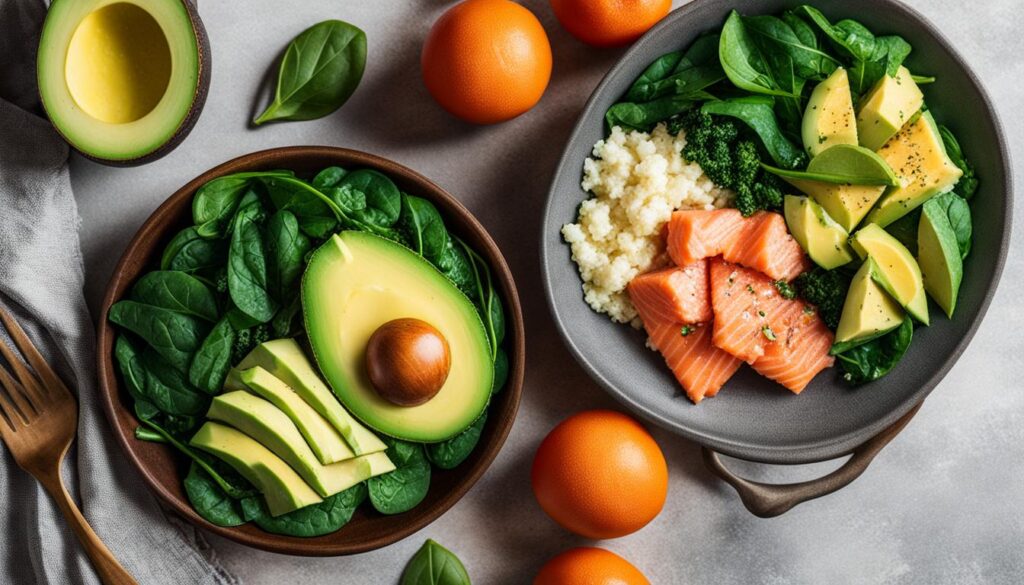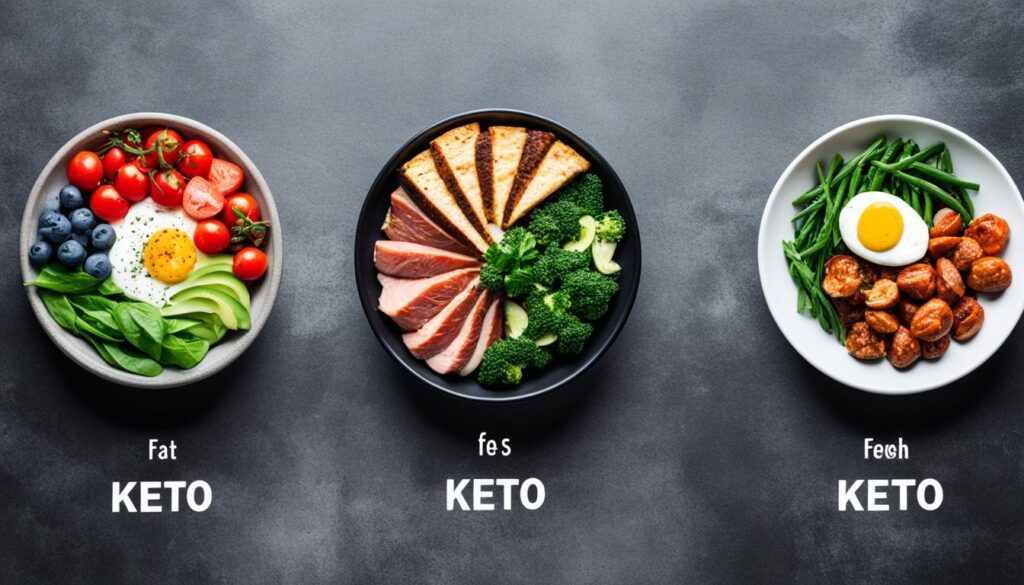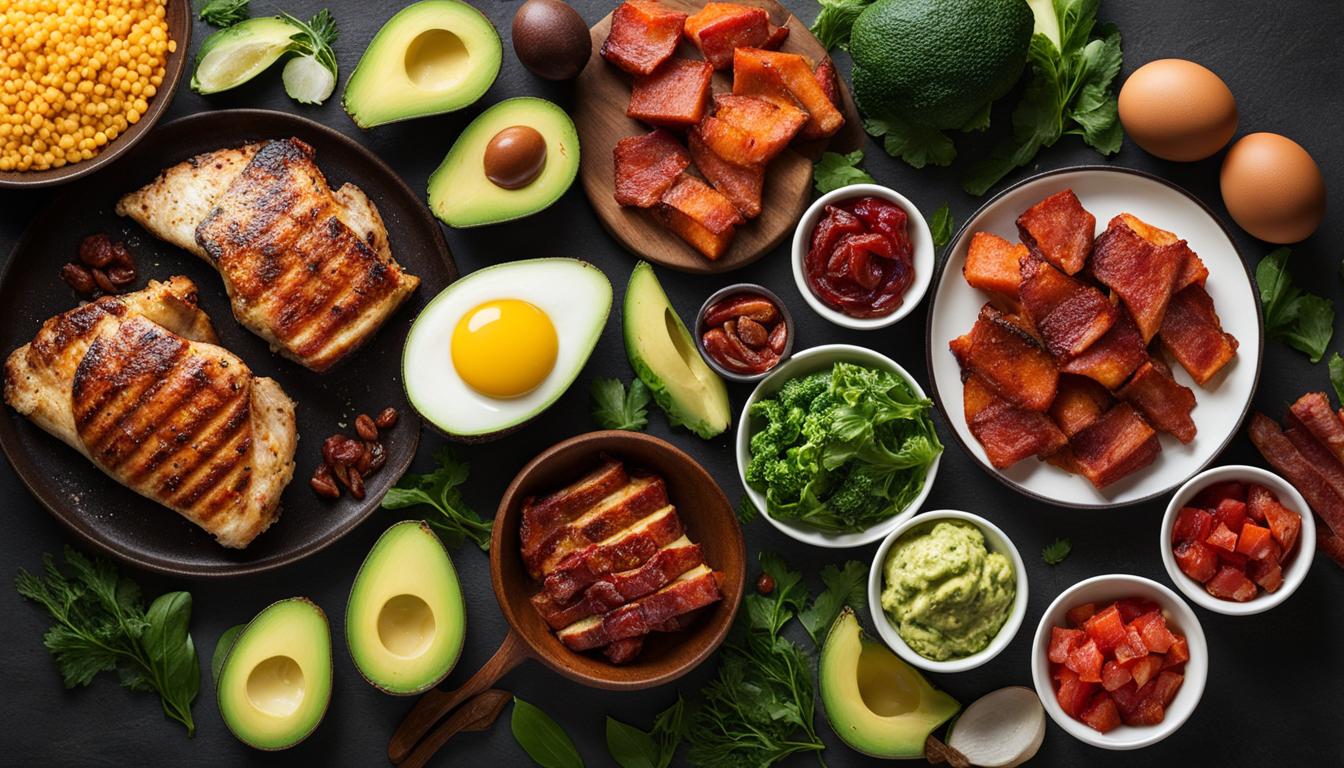When it comes to healthy eating and weight loss, choosing the right diet can be a daunting task. With so many options available, it’s important to consider a sustainable diet that aligns with your lifestyle choices and long-term health goals. In this article, I will compare two popular diets – Keto and Paleo – and help you decide which one is right for you.
Key Takeaways:
- Both Keto and Paleo diets focus on whole foods and offer potential nutritional benefits.
- Keto diet aims to shift the body’s dependence from carbs to fat for energy, while Paleo diet emphasizes foods available to early humans.
- The Paleo diet incorporates lifestyle practices and eliminates grains, legumes, and most processed foods.
- The Keto diet focuses on macronutrient distribution, prioritizing high fat intake and very low carb intake.
- Consider your personal preferences, health goals, and consult with a healthcare professional before choosing a diet.
What is the Paleo Diet?
The paleo diet, also known as “the caveman diet,” is a nutritional approach based on the principle of consuming foods available to early humans. The aim is to optimize health and well-being by following a diet that resembles what our ancestors would have eaten. The paleo diet emphasizes the consumption of whole foods while eliminating grains, legumes, processed sugar, and most sources of dairy.
On the paleo diet, you can enjoy a variety of nutrient-dense foods that align with the principles of eating like a caveman. These include:
- Meat: Lean cuts of grass-fed beef, pork, poultry, and game meats.
- Fish: Wild-caught varieties such as salmon, sardines, and mackerel.
- Eggs: From free-range chickens.
- Nuts and Seeds: Almonds, walnuts, macadamia nuts, chia seeds, and flaxseeds.
- Fruits and Vegetables: Non-starchy options like berries, leafy greens, peppers, and cruciferous vegetables.
- Healthy Fats: Avocado, olive oil, coconut oil, and grass-fed butter.
- Minimally Processed Sweeteners: Raw honey, maple syrup, and coconut sugar.
The paleo diet not only focuses on food choices but also incorporates lifestyle practices. It promotes environmental impact awareness, encourages mindful eating, and emphasizes total body wellness. By following the paleo diet, you prioritize nutrient-dense whole foods and eliminate processed and inflammatory foods that can negatively impact your health.
“The paleo diet emphasizes the consumption of whole foods while eliminating grains, legumes, processed sugar, and most sources of dairy.”

What is the Keto Diet?
The keto diet, short for ketogenic diet, is a popular eating plan that focuses on restricting carbohydrates and increasing the consumption of healthy fats. It is a low carb, high-fat diet that aims to shift the body’s reliance on carbs as the primary source of energy to fat.
On the keto diet, the macronutrient distribution of meals is carefully controlled. The primary focus is on high fat intake, moderate protein intake, and very low carb intake. By severely limiting carb intake, the body enters a metabolic state known as ketosis, where it starts breaking down fat to produce ketones for energy instead of glucose.
Ketosis is the key mechanism behind the keto diet. It triggers the breakdown of stored fat in the body, leading to weight loss. When the body is in ketosis, it becomes an efficient fat-burning machine.
The keto diet offers various benefits beyond weight loss. It is known to improve blood sugar control, as it reduces the need for insulin by limiting carbohydrate intake. This makes it a particularly popular choice for individuals with diabetes or insulin resistance.
It’s important to note that the keto diet requires careful planning and monitoring to ensure adequate intake of vitamins, minerals, and fiber. It’s also crucial to consult with a healthcare professional before embarking on any new diet, especially if you have underlying health conditions or take medication.

Benefits of the Keto Diet:
- Weight loss through fat breakdown
- Improved blood sugar control
- Potential reduction in hunger and cravings
- Increased energy levels
- Improved mental focus and clarity
Potential Drawbacks of the Keto Diet:
- Initial adjustment period with potential side effects, often referred to as the “keto flu”
- Restrictive nature of the diet, making it challenging to follow long-term
- Potential nutrient deficiencies, especially if not planned properly
- May not be suitable for individuals with certain medical conditions or a history of eating disorders
Despite its potential benefits, the keto diet is not for everyone. It’s essential to consider your individual needs, preferences, and overall health goals when deciding whether to adopt the keto diet as a part of your lifestyle. Consulting with a healthcare professional or registered dietitian can provide personalized guidance and support along your journey.
Similarities between Paleo and Keto
Despite their differences, the paleo and keto diets share several similarities. Both diets emphasize the consumption of whole foods and encourage the elimination of grains, legumes, and added sugar. They both also emphasize the importance of consuming healthy fats and have the potential for weight loss. Both diets prioritize the use of fresh vegetables, meat, fish, and nuts in their meal plans.
When it comes to the paleo diet, the focus is on consuming foods that humans have been eating for thousands of years and avoiding processed and refined options. This means more lean meats, seafood, fruits, vegetables, nuts, and seeds. Similarly, the keto diet promotes a high intake of healthy fats, moderate protein, and minimal carbohydrates, aiming to put the body in a state of ketosis where it burns fat for fuel.
Both the paleo and keto diets promote the consumption of whole foods, which are nutrient-dense and provide a wide range of vitamins, minerals, and antioxidants. By eliminating or greatly reducing the intake of processed foods, grains, and added sugars, these diets encourage healthier eating habits and can contribute to improved overall health and wellbeing.
Moreover, both diets have shown potential for weight loss. By cutting out refined carbohydrates and focusing on whole foods, individuals following either diet may experience weight loss due to reduced calorie intake and improved metabolic function.

Differences between Paleo and Keto
While the paleo and keto diets have similarities, they also have some key differences. Let’s take a closer look at the variations between the two:
Paleo Diet
The paleo diet is not only about the foods you consume but also includes additional lifestyle practices. It encourages specific exercise recommendations and stress reduction techniques. Unlike the keto diet, the paleo diet does not place restrictions on macronutrients. It allows for whole-food carbs, primarily in the form of fruits and non-starchy vegetables.
Keto Diet
The keto diet, on the other hand, focuses solely on macronutrient distribution. It restricts all rich sources of carbohydrates, including starchy vegetables, most fruits, grains, sweeteners, and legumes. The primary goal of the keto diet is to shift the body’s dependence from carbs to fat for energy, achieving a state of ketosis.
| Paleo Diet | Keto Diet |
|---|---|
| Includes lifestyle practices | Strictly focuses on macronutrient distribution |
| Allows for whole-food carbs | Restricts all rich sources of carbohydrates |
| Emphasizes exercise and stress reduction | Does not involve specific lifestyle practices |
In summary, while the paleo and keto diets share similarities in their emphasis on whole foods, the paleo diet incorporates lifestyle practices and allows for whole-food carbs. The keto diet solely focuses on macronutrient distribution and restricts all rich sources of carbohydrates.

Pros and Cons of the Paleo Diet
The paleo diet, with its focus on whole foods and nutrient-dense ingredients, has both pros and cons. It is important to consider these aspects before deciding if it is the right eating plan for you.
Pros of the Paleo Diet
- Nutrient-Dense Foods: The paleo diet encourages the consumption of nutrient-dense whole foods, such as fruits, vegetables, lean meats, nuts, and seeds. These foods are rich in vitamins, minerals, and antioxidants, which can support overall health and wellbeing.
- Potential for Weight Loss: The paleo diet’s emphasis on whole foods and the elimination of processed foods and refined carbs can lead to weight loss. By focusing on nutrient-dense foods, you may naturally consume fewer calories, resulting in weight loss.
- Elimination of Processed Foods: The paleo diet promotes the elimination of processed foods, which are often high in added sugars, unhealthy fats, and artificial ingredients. By removing these from your diet, you may experience improved energy levels and overall wellbeing.
Cons of the Paleo Diet
- Restrictive: The paleo diet can be restrictive, as it eliminates foods such as grains, legumes, and dairy. This may make it challenging to adhere to the diet in the long term, especially for individuals with dietary preferences or restrictions.
- Lack of Scientific Evidence: While the paleo diet has gained popularity, there is limited scientific evidence to support its claims. Some critics argue that the diet’s restrictions are not based on solid research, making it important to approach the paleo diet with caution and seek personalized guidance.
- Potential Nutrient Imbalances: The elimination of certain food groups in the paleo diet may result in nutrient imbalances if not carefully planned. It is essential to ensure that you are obtaining all necessary nutrients, including calcium, vitamin D, and fiber, through alternative sources.
In summary, the paleo diet offers the benefits of nutrient-dense whole foods and the potential for weight loss. However, it is important to consider its restrictive nature and limited scientific evidence. Careful planning and individualized guidance are crucial to ensure a balanced and sustainable approach to the paleo diet.
Pros and Cons of the Keto Diet
The keto diet, short for ketogenic diet, has gained popularity due to its potential for weight loss, fat burning, and blood sugar control. However, like any eating plan, it has its pros and cons that should be considered.
Pros of the Keto Diet
- Weight loss: The keto diet is known for its ability to promote weight loss, especially in the form of fat loss. By restricting carbohydrates and increasing fat intake, the body is forced to burn stored fat for fuel, leading to weight loss.
- Fat burning: By entering a state of ketosis, where the body relies on fat for energy instead of carbohydrates, the keto diet can enhance fat burning processes in the body.
- Blood sugar control: The keto diet has shown promising effects in improving blood sugar levels and insulin sensitivity, making it a potential option for individuals with diabetes or prediabetes.
Cons of the Keto Diet
- Restrictive nature: The keto diet is highly restrictive and requires significant changes to one’s eating habits. It involves strict limitations on carbohydrate intake and relies heavily on high-fat foods.
- Potential nutrient deficiencies: Due to the limited food choices on the keto diet, there is a risk of nutrient deficiencies, particularly in important vitamins and minerals found in fruits, whole grains, and legumes.
- Keto flu: Many individuals experience initial side effects when transitioning to the keto diet, known as the “keto flu.” Symptoms may include nausea, headache, fatigue, and constipation as the body adjusts to the new way of eating.
It’s important to note that the keto diet may not be suitable for everyone. Individuals with a history of eating disorders or certain medical conditions should consult with a healthcare professional before embarking on this diet plan.
| Pros of the Keto Diet | Cons of the Keto Diet |
|---|---|
| – Potential for weight loss | – Restrictive nature |
| – Fat burning | – Potential nutrient deficiencies |
| – Blood sugar control | – Keto flu |
Considerations for Choosing the Right Diet
When it comes to choosing between the paleo and keto diet, there are several important considerations to keep in mind. Your personal preferences, health goals, and dietary restrictions play a key role in determining which diet is the best fit for you. It’s crucial to choose a diet that is sustainable in the long term, allowing you to maintain healthy eating habits and meet your nutritional needs.
If you have specific health goals, such as weight loss or blood sugar control, it’s important to evaluate how each diet aligns with those goals. The paleo diet focuses on whole foods and the elimination of processed ingredients, which can support overall health and weight management. On the other hand, the keto diet is highly effective for weight loss and may have benefits for blood sugar control due to its low carb and high-fat approach.
Additionally, if you have dietary restrictions or allergies, it’s essential to consider how each diet accommodates those needs. The paleo diet eliminates grains, legumes, and most sources of dairy, which can be beneficial for individuals with gluten intolerance or lactose intolerance. The keto diet, on the other hand, restricts all sources of carbohydrates, which may be challenging for those with certain dietary restrictions.
It’s always a good idea to consult with a healthcare professional or registered dietitian before embarking on a new diet plan. They can provide individualized guidance based on your specific needs and ensure that you are meeting your nutritional requirements. They can also help you navigate any potential challenges or concerns that may arise during the transition to a new diet.
At a Glance: Choosing the Right Diet
| Diet | Sustainability | Personal Preferences | Health Goals | Dietary Restrictions | Consult a Healthcare Professional |
|---|---|---|---|---|---|
| Paleo | Sustainable long-term | May align with preference for whole foods | Supports overall health and weight management | Eliminates grains, legumes, and most sources of dairy | Recommended |
| Keto | May be more restrictive long-term | May align with preference for high-fat foods | Effective for weight loss; may benefit blood sugar control | Restricts all sources of carbohydrates | Recommended |
Remember, choosing the right diet is a personal decision that should take into account your unique circumstances and preferences. What works for one person may not work for another, so it’s important to listen to your body and make choices that support your overall health and wellbeing.
A Balanced Approach: Keto-Paleo Diet
For those who want a balanced approach, a keto-paleo diet can be considered. This approach combines elements of both diets, allowing for a variety of nutrient-rich carbohydrates from fruits and non-starchy vegetables, high-quality protein sources, and healthy fats. By emphasizing natural, whole foods, the keto-paleo diet provides a well-rounded nutritional profile while still adhering to the principles of both diets.
On the keto-paleo diet, you can enjoy a range of nutrient-dense carbohydrates sourced from fruits and non-starchy vegetables. These carbohydrates offer essential vitamins, minerals, and dietary fiber, supporting overall health and digestion.
The inclusion of high-quality protein sources is another key aspect of the keto-paleo diet. Lean meats, fish, poultry, and plant-based proteins like nuts and seeds ensure that you meet your protein needs without compromising on taste or variety. Protein is essential for muscle growth, repair, and overall body function.
Healthy fats, such as those found in avocados, olive oil, and coconut oil, are also an integral part of the keto-paleo diet. These fats provide energy, support brain health, and help absorb fat-soluble vitamins. They can also help keep you feeling satisfied and satiated throughout the day.
By focusing on natural foods and whole ingredients, the keto-paleo diet encourages a clean and unprocessed eating pattern. This approach is aligned with the principles of both the keto and paleo diets, promoting overall health and wellbeing.
Incorporating a balanced approach like the keto-paleo diet allows you to enjoy the benefits of both diets while tailoring them to your individual preferences and needs. It offers flexibility in food choices and can be customized to suit different dietary restrictions or lifestyle preferences.
Benefits of a Balanced Keto-Paleo Diet:
- Provides a wide range of nutrients from nutrient-rich carbohydrates, high-quality protein, and healthy fats
- Promotes overall health and wellbeing by emphasizing natural, whole foods
- Offers flexibility and customization to suit individual preferences and dietary restrictions
By adopting a balanced keto-paleo diet, you can enjoy a sustainable and satisfying approach to healthy eating that encompasses various aspects of both diets.
Tips for Success on Keto or Paleo
When embarking on the keto or paleo diet, there are several key tips for success that can help you stay on track and reach your health and wellness goals. Whether you are following the keto diet’s low-carb, high-fat approach or embracing the paleo diet’s focus on whole foods, these tips can enhance your experience and ensure a sustainable and enjoyable journey:
1. Meal Planning and Food Prepping
One of the essential strategies for success on either the keto or paleo diet is meal planning and food prepping. By taking the time to plan your meals in advance and prepare them ahead of time, you can avoid impulsive food choices and ensure that you have nutritious options readily available. This can prevent you from reaching for unhealthy snacks or resorting to fast food when hunger strikes.
2. Staying Hydrated
Hydration is crucial for overall health and well-being, regardless of the diet you choose. It is especially important when following the keto or paleo diet as both can have diuretic effects. Make sure to drink plenty of water throughout the day. You can also supplement with herbal teas or infused water to add variety and flavor to your hydration routine.
3. Monitoring Progress
Regularly monitoring your progress can help keep you motivated and on track. Consider using a food diary or a mobile app to track your meals, as well as your physical activity and any changes in your body composition. This can provide valuable insights into how the diet is affecting your overall health, weight loss, and other goals. Remember that progress takes time, and focusing on milestones rather than instant results will help you stay committed to your journey.
4. Seeking Support
Embarking on a new dietary journey can be challenging, which is why seeking support is crucial. Joining a community of like-minded individuals, whether online or in-person, can provide motivation, inspiration, and a platform to share experiences and tips. Additionally, consulting with a healthcare professional or a registered dietitian can provide personalized guidance and ensure you are meeting your nutritional requirements.
Remember, these tips are meant to enhance the success of your keto or paleo journey. It’s important to listen to your body and make adjustments as necessary to ensure the diet is sustainable and enjoyable for you. By incorporating these strategies and staying committed to your health goals, you can achieve long-lasting success on the keto or paleo diet.
Conclusion
When it comes to choosing the right diet, it’s essential to consider your individual needs, preferences, and long-term sustainability. Both the keto and paleo diets have their benefits and drawbacks, and what works for one person may not work for another. It’s important to prioritize a sustainable lifestyle and make choices that align with your overall health goals and wellbeing.
As I’ve discussed throughout this article, the paleo diet emphasizes whole foods and the elimination of grains, legumes, and processed foods. On the other hand, the keto diet focuses on controlling macronutrient distribution to shift the body’s dependence from carbs to fat for energy.
Ultimately, the best diet for you is one that you can adhere to and enjoy in the long term. Consider your personal preferences, dietary restrictions, and consult with a healthcare professional or registered dietitian for personalized guidance. Remember, there is no one-size-fits-all approach to nutrition. It’s about finding what works for you and creating a sustainable lifestyle that supports your individual needs and preferences.
FAQ
What is the paleo diet?
The paleo diet, also known as “the caveman diet,” is based on the principle of eating foods available to early humans for optimal health. It emphasizes whole foods and eliminates grains, legumes, processed sugar, and most sources of dairy.
What is the keto diet?
The keto diet is a low carb, high-fat eating plan that aims to shift the body’s dependence from carbs to fat for energy. It involves controlling the macronutrient distribution of meals, with a focus on high fat intake, moderate protein intake, and very low carb intake.
What are the similarities between the paleo and keto diets?
Both diets emphasize the consumption of whole foods and encourage the elimination of grains, legumes, and added sugar. They also prioritize the use of fresh vegetables, meat, fish, and nuts in their meal plans.
What are the differences between the paleo and keto diets?
The paleo diet incorporates additional lifestyle practices, allows for whole-food carbs, and does not place restrictions on macronutrients. The keto diet focuses solely on macronutrient distribution and restricts all rich sources of carbohydrates.
What are the pros and cons of the paleo diet?
The paleo diet promotes the consumption of nutrient-dense whole foods, has the potential for weight loss, and encourages the elimination of processed foods. However, it can be restrictive, lacking scientific evidence, and may require careful planning to ensure all necessary nutrients are obtained.
What are the pros and cons of the keto diet?
The keto diet has shown potential for weight loss and blood sugar control. However, it is a restrictive diet that may lead to potential nutrient deficiencies and initial side effects known as the “keto flu.” It may also be unsuitable for certain individuals with eating disorders or certain medical conditions.
What should I consider when choosing the right diet?
Consider your personal preferences, health goals, dietary restrictions, and consult with a healthcare professional to determine which diet aligns best with your needs and ensures you are meeting your nutritional requirements.
What is a balanced approach to the keto and paleo diets?
A balanced approach, known as the keto-paleo diet, combines elements of both diets by allowing for nutrient-rich carbohydrates, high-quality protein sources, and healthy fats. It emphasizes natural, whole foods while maintaining the principles of both diets.
What tips can help me succeed on the keto or paleo diet?
Plan meals and food prep in advance, stay hydrated, monitor progress regularly, and seek support from a community or healthcare professional. Listen to your body and make adjustments as necessary to ensure the diet is sustainable and enjoyable.
What should I keep in mind when choosing the right diet?
Consider your individual needs, preferences, and long-term sustainability. Prioritize a sustainable lifestyle and make choices that align with your overall health goals and wellbeing. Seek guidance from a healthcare professional to help ensure you make the right dietary choices for your unique needs.


[…] a sustainable and healthy diet is not only beneficial for your own well-being but also for the environment. By reducing your […]